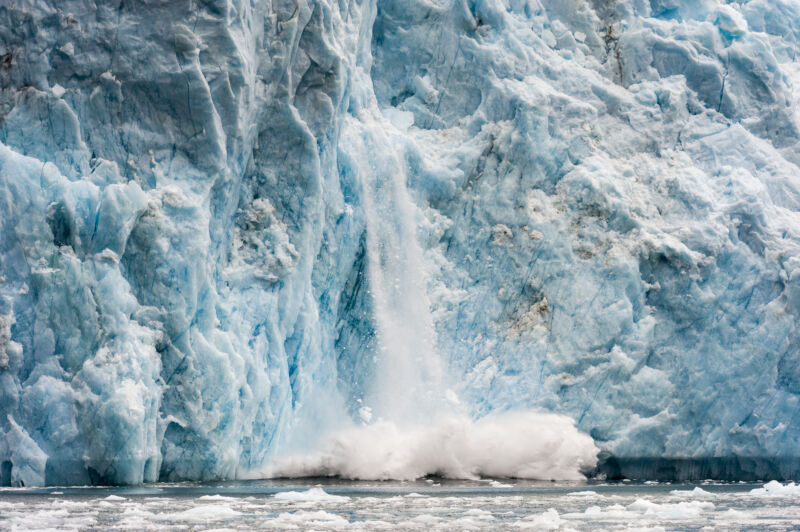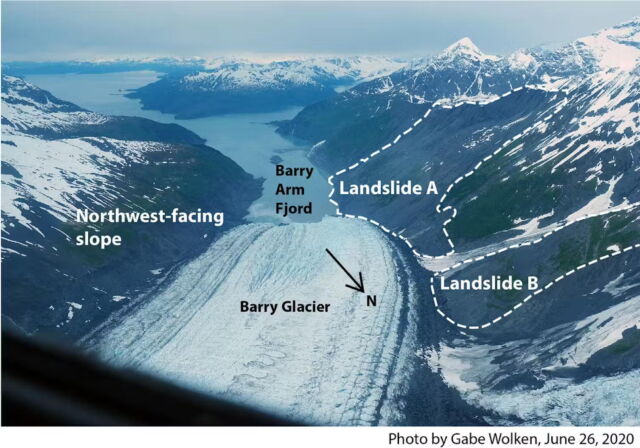
Earthquake scientists have detected an unusual signal at observatories used to detect seismic activity in September 2023. We’ve seen it in sensors everywhere, from the Arctic to Antarctica.
We were confused – the signal was not as recorded before. Instead of the high-frequency rumble typical of earthquakes, it was a monotonous sound with a single resonant frequency. Even more puzzling is that the signal continued for nine days.
Initially classified as a “USO”—an unidentified seismic object—the source of the signal was eventually traced to a massive landslide in Greenland’s remote Dixon Fjord. Rock and ice, enough to fill 10,000 Olympic-sized swimming pools, plunged into the fjord, triggering a 200-meter-high mega-tsunami and triggering a phenomenon known as a seiche: a wave that continued into the icy fjord. Slash back and forth about 10,000 times over nine days.
In the wake of the tsunami, that 200-meter wave was twice the height of London’s Big Ben and many times larger than anything recorded after the massive undersea earthquakes in Indonesia in 2004 (the Boxing Day tsunami) or Japan in 2011. (Tsunami that hit the Fukushima nuclear power plant). It may be the tallest wave anywhere on Earth Since 1980.
Our findings, now published in the journal ScienceIt relies on collaboration with 66 scientists from 40 institutions in 15 countries. As with plane crash investigations, solving this mystery required piecing together a wide range of sources, from a trove of seismic data to satellite images, in-fjord water level monitors and detailed simulations of how the tsunami wave formed.
All of these highlight a series of catastrophic, catastrophic events that take decades to seconds before collapse. The landslide traveled down a very steep glacier in a narrow valley and plunged into a narrow, confined fjord. Eventually, decades of global warming thinned the glacier by tens of meters, meaning it could no longer hold the mountain that towered above it.
Unspecified water bodies
But beyond the whimsy of this scientific miracle, the phenomenon underscores a deep and unsettling truth: Climate change is reshaping our planet and our scientific methods in ways we’re only beginning to understand.
It is a stark reminder that we are sailing in uncharted waters. A year ago, the idea that a seach could last nine days would have been dismissed as absurd. Similarly, a century ago, the idea that warming would disrupt slopes in the Arctic, leading to massive landslides and tsunamis occurring almost annually, was considered far-fetched. Yet these once unthinkable events are now upon us New Reality.
“Once unthinkable” waves are sweeping the world.
As we move deeper into this new era, we can expect many events that defy our previous understanding, because our experience does not encompass the extreme conditions we now face. We saw a nine-day wave that no one had ever imagined.
Traditionally, discussions of climate change have focused on looking upward and outward with weather patterns changing the atmosphere and oceans and rising sea levels. But Dixon Fjord forces us to look down, at the crust beneath our feet.
Perhaps for the first time, climate change has triggered a seismic event with global implications. A landslide in Greenland sent tremors through the Earth, shaking the planet and creating seismic waves that traveled around the world within an hour of the event. No area beneath our feet is immune from these vibrations, metaphorically opening cracks in our understanding of these phenomena.
It will happen again
Although landslide-tsunamis have been recorded before, the first was observed in September 2023 in East Greenland, an area that has been resistant to the events driving this catastrophic climate change.
This certainly won’t be the last landslide-megatsunami. As permafrost continues to warm and glaciers thin on steep slopes, these events can be expected to occur. More often and on a larger scale Across the polar and mountainous regions of the world. Recently identified unstable slopes West Greenland And inside Alaska Clear examples of disasters.

Cape Volcan/USGS
As we face these extreme and unexpected events, it is clear that our current scientific methods and toolkits must be fully prepared to deal with them. We do not have a standard workflow for analyzing the 2023 Greenland event. We must adopt a new mindset because our current understanding has been shaped by a now perishing, previously stable climate.
As we continue to alter our planet’s climate, we must be prepared for unexpected events that challenge our current understanding and demand new ways of thinking. The ground beneath us is literally and figuratively shaking. While the scientific community must adapt and pave the way for informed decisions, decision makers must act.
The authors discuss their findings in more depth.
Stephen Hicks A Research Fellow in Computational Seismology, UCL And Christian Svennevik A Senior Researcher, Department of Mapping and Mineral Resources, Geological Survey of Denmark and Greenland
This article has been republished Conversation Under Creative Commons License. Read on Original article.